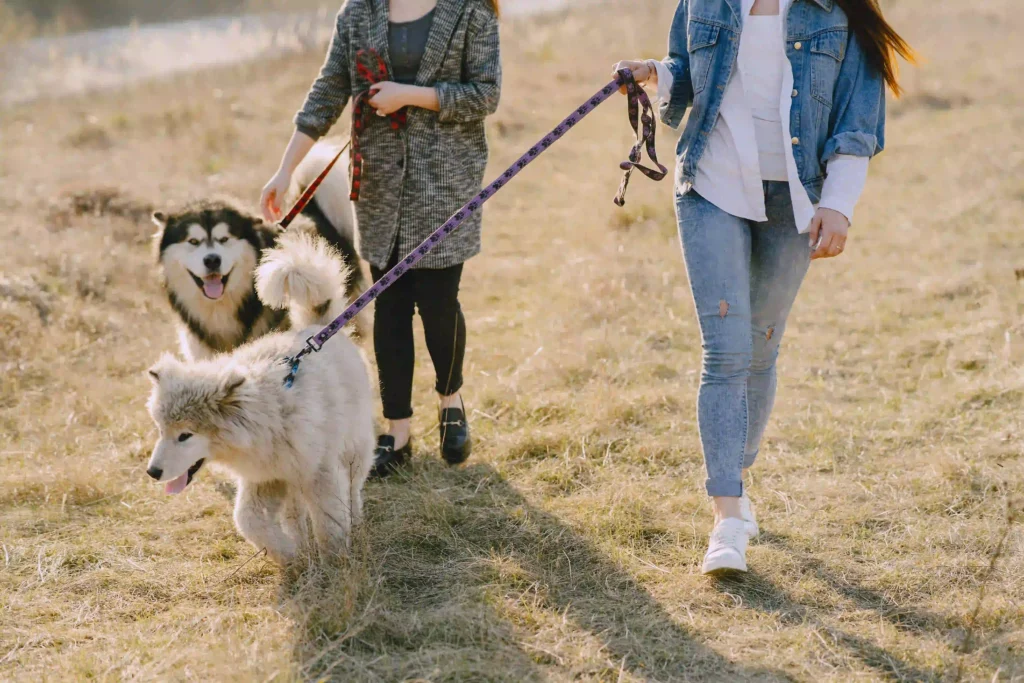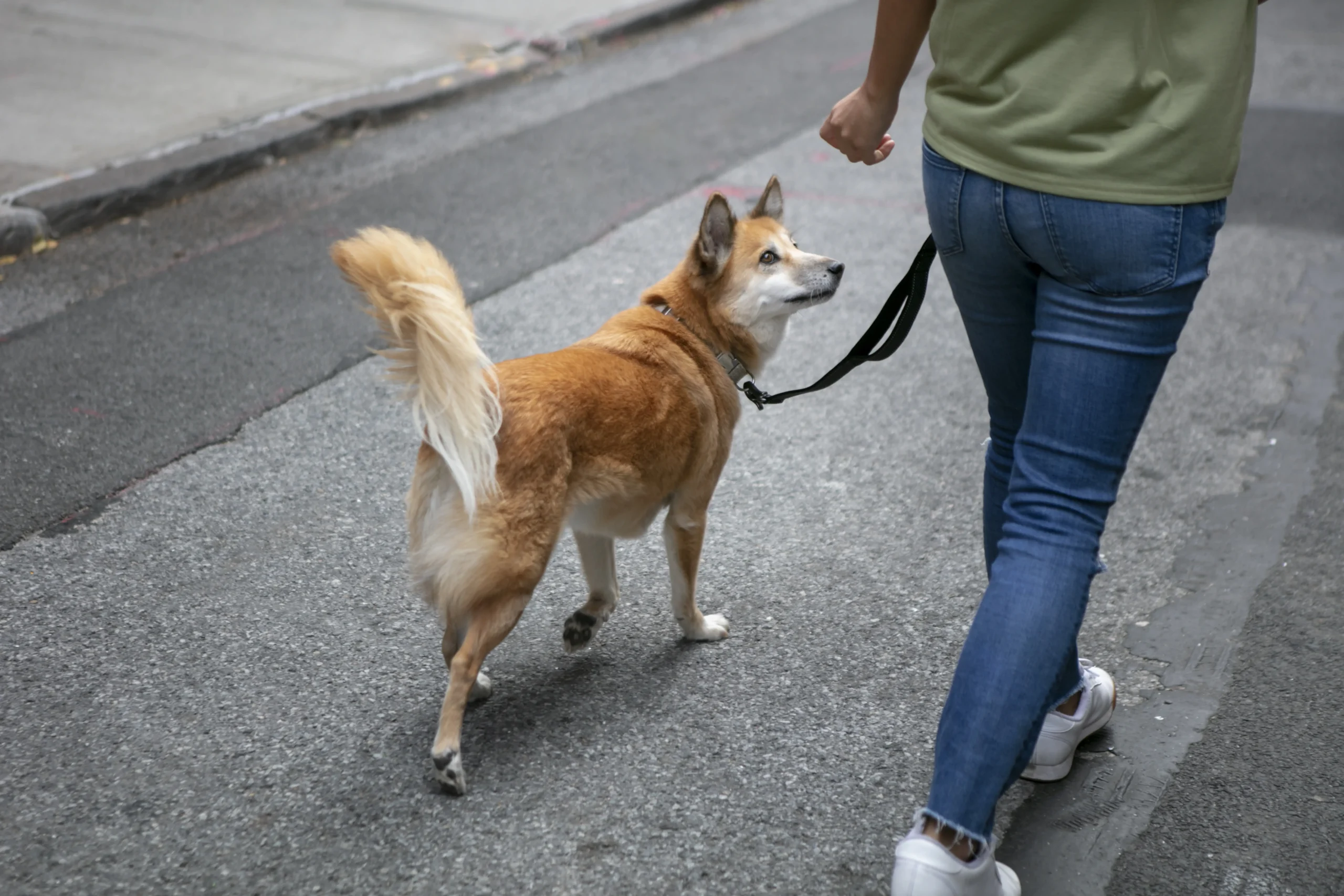Written by Deborah Foster, Certified Dog Trainer & Canine Behavior Specialist with 10+ years of experience in leash training, obedience, and behavior improvement. Reviewed by Erik Prins, ADAB, CCAB.
8-Minute Read
Why Dogs Pull & How Leash Training Builds Trust
Dogs pull on the leash because it’s their natural instinct to explore and move quickly. When they feel tension on the leash, many dogs instinctively pull against it, thinking it’s a game or a challenge. According to the American Kennel Club (AKC), pulling is often a sign of excitement or curiosity, not disobedience. For example, breeds like Huskies and Beagles are genetically predisposed to pull—Huskies because they were bred to sled, and Beagles because they’re scent hounds.
Leash training is more than just teaching your dog to walk politely—it’s about building trust and communication. A well-trained dog understands that staying close to you means safety and rewards. This bond is especially important in high-stress situations, like encountering other dogs or navigating busy streets.
Expert Tip: Certified trainer Jamie Rahtz says, “Dogs pull because they’ve learned it works. If pulling gets them to the park faster, they’ll keep doing it. The key is to teach them that walking calmly gets them what they want.”
Real Owner Review: “My Labrador used to drag me down the street. After learning about leash pressure and using treats to reward calm behavior, walks are now enjoyable for both of us!” – Emily R., Chicago
Guide to Train Your Dog to Walk on a Leash Without Tugging
Leash pulling is a common issue among dogs, but with proper training, they can learn to walk calmly beside you. Start by selecting the right equipment, such as a no-pull harness or a fixed-length leash, to give you better control. Before heading outside, practice leash training indoors or in a quiet space, rewarding your dog for maintaining a loose leash. This helps them associate calm walking with positive reinforcement.
Once your dog is comfortable, introduce outdoor walks in a low-distraction area. Use a consistent verbal cue like “let’s go” and reward them when they walk without pulling. If your dog starts tugging, immediately stop walking and wait until they loosen the tension before moving again. This teaches them that pulling won’t speed up the walk. Additionally, changing directions frequently keeps them engaged and encourages them to pay attention to you. Short, structured training sessions work best, as they prevent frustration and reinforce good behavior.
Expert Tips to Prevent Leash Pulling and Improve Walking Behavior
To prevent leash pulling, professional trainers recommend using high-value treats, interactive play, and structured training exercises. Dogs naturally pull due to excitement or curiosity, so patience and consistency are crucial. Avoid retractable leashes, which encourage pulling, and instead opt for a standard 4-6 ft leash for better control. If your dog is highly reactive to distractions, try impulse control exercises such as “sit” and “stay” before heading out.
Dog Training Cost in 2025: Comprehensive Price Guide
Another effective technique is the “turnaround method.” If your dog pulls forward, immediately change direction, encouraging them to follow you. This reinforces that paying attention to you results in movement, while pulling does not. Consistently rewarding calm walking and gradually increasing distractions during training will strengthen their leash manners. Over time, your dog will learn that staying close to you is the key to an enjoyable walk.
Leash Training Gear: What Works (and What’s Harmful)
Choosing the right equipment is crucial for effective leash training. A front-clip harness is ideal for pullers because it redirects their momentum toward you when they pull. For dogs that are easily distracted, a head halter can provide gentle control without choking. However, flat collars are best for dogs that already walk well on a leash, as they’re simple and lightweight.
Avoid retractable leashes during training—they encourage pulling and offer little control in emergencies. According to the Pet Professional Guild, retractable leashes can also cause injuries to both dogs and owners, such as rope burns or neck strain.
Expert Tip: “Fit is everything. A harness that’s too tight can chafe, and one that’s too loose won’t provide control. You should be able to fit two fingers snugly under the straps.” – Kimberly Artley, DVM
Real Owner Review: “Switching to a front-clip harness was a game-changer for my German Shepherd. He stopped pulling almost immediately!” – Mark T., Austin

Your 3-Phase Leash Training Plan
Phase 1: Foundation (Indoor Training)
Start by getting your dog comfortable with their leash and collar or harness. Let them wear the gear indoors for short periods while rewarding them with treats and praise. This helps them associate the equipment with positive experiences.
Next, practice basic commands like “heel” and “sit” in a low-distraction environment. Use treats to lure your dog to your side and reward them for staying close. This phase is all about building confidence and focus.
Real Owner Review: “I thought my puppy would never get used to the leash, but after a week of indoor training, he was walking like a pro!” – Sophie L., Denver
Phase 2: Outdoor Basics (Low Distraction)
Once your dog is comfortable indoors, move to a quiet outdoor space like your backyard or a deserted park. Use treats to reward loose-leash walking—whenever the leash is slack, say “yes!” and give a treat.
If your dog pulls, stop walking and wait for them to return to your side. This teaches them that pulling won’t get them where they want to go. Consistency is key—every walk is a training opportunity.
Expert Tip: “Don’t rush this phase. It’s better to spend extra time in low-distraction areas than to move too quickly and overwhelm your dog.” – Victoria Stilwell, Positively Dog Training
Phase 3: Advanced Training (Real-World Proofing)
Gradually introduce distractions like other dogs, cyclists, or noisy streets. Start at a distance where your dog notices the distraction but remains calm, then reward heavily. Over time, decrease the distance as your dog improves.
For reactive dogs, consider using a “look at me” command to redirect their focus. Toss treats at your feet to keep their attention on you. This phase requires patience, but the payoff is worth it.
Expert Tip: “Practice in different environments to generalize the behavior. A dog that walks well in your neighborhood might struggle in a new park.” – Pat Miller, Certified Dog Behavior Consultant
Real Owner Review: “My rescue dog used to lunge at every squirrel, but now he checks in with me instead. It’s amazing!” – Laura M., New York
Fixing 5 Common Leash Problems
“My Dog Lunges at Other Dogs!”
Lunging is often a sign of fear or overexcitement. Create distance from the trigger and reward calm behavior. Over time, your dog will learn that other dogs mean good things (like treats).
Expert Tip: “Teach your dog to focus on you before they react. A strong ‘look at me’ command can be a lifesaver.” – Jean Donaldson, Dog Trainer
“He Hates the Leash!”
Some dogs are sensitive to the feel of a leash. Introduce it gradually by leaving it near their food bowl or playing with it during fetch. Swap to a lighter leash if needed.
Expert Tip: “Pair the leash with something your dog loves, like treats or playtime. This creates a positive association.” – Dale McCluskey, Dog Trainer and Author
“She Pulls Nonstop!”
Use a front-clip harness to reduce pulling, and practice the “be a tree” method—stop moving whenever your dog pulls. Reward them for returning to your side.
Expert Tip: “Tire your dog out before walks. A tired dog is less likely to pull.” – Cesar Millan, Dog Behaviorist
“Puppy Bites the Leash!”
Puppies explore the world with their mouths. Redirect biting by offering a chew toy or spraying the leash with a bitter apple spray.
Expert Tip: “Teach your puppy that letting go of the leash earns them a treat. This builds impulse control.” – Frania Shelley-Grielen, Animal Behavior (MA)
“My Arms Hurt from Pulling!”
Wrap the leash around your waist for better leverage, and practice engagement exercises like treat-dispensing toys.
Expert Tip: “Strengthen your bond with your dog through play and training. A connected dog is less likely to pull.” – Elizabeth Beck, Animal Behaviorist
What to Put on Rope Burn from Dog Leash: Quick Relief Tips
Pro Tips from Trainers: What Most Owners Miss
- Your energy matters: Dogs are highly attuned to your emotions. If you’re stressed, your dog will be too. Practice deep breathing and stay calm during walks.
- Reward the “check-in”: When your dog voluntarily looks at you, toss a party! This reinforces their focus on you.
- Skip retractable leashes: They encourage pulling and lack control in emergencies.
Case Study: A 2-year-old rescue Pitbull reduced pulling by 80% in 3 weeks using the “stop-and-reward” method.
Conclusion: Leash Training Is a Journey, Not a Race
Leash training is one of the most rewarding investments you can make in your relationship with your dog. It’s not just about preventing pulling or lunging—it’s about building trust, communication, and a deeper bond. Remember, every dog learns at their own pace, and setbacks are normal. What matters most is consistency, patience, and a positive attitude.
Whether you’re working with a spirited puppy or a stubborn senior, the techniques in this guide will help you achieve calm, enjoyable walks. Celebrate the small victories along the way, like the first time your dog walks beside you without tugging or the moment they choose to check in with you instead of chasing a squirrel.
FAQ: Quick Answers from a Certified Trainer
Q: How long does leash training take?
A: Puppies: 2-4 weeks. Adult dogs: 4-8 weeks. Consistency is key!
Q: Are prong collars effective?
A: They suppress behavior but damage trust. Positive reinforcement works better long-term.
Q: Can old dogs learn?
A: Absolutely! My oldest student was a 12-year-old Dachshund.
